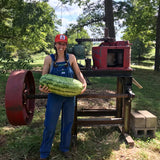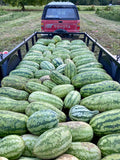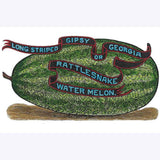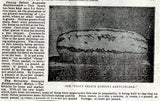Georgia Rattlesnake Watermelon
Citrullus lanatus
These great-tasting, snake-striped heirloom watermelons from the 19th century grow to about 35 lbs or even larger! Their solid rinds help them travel and store well. Our friend Chelsea Askew grew these melons in her corn patch and saved their seeds on the first snow. She made watermelon wine from all the extra sweet, red flesh that she couldn't eat fresh. For an extensive history of this important watermelon, scroll to the bottom of this page!
Watermelons originate in West Africa, where they have been cultivated for at least four thousand years.
Thank you to Chelsea Askew for these seeds and photos, and to David Shields for his historical research and for sharing the newsprint and drawing of this melon.
Days to maturity: 90
Seeds per pack: 28-30
Germination rate: 97% on 01/17/2025
Planting / harvesting notes
Direct sow in warm soil after the last frost, or seed indoors 3-4 weeks beforehand and transplant. Space 12-18" apart in rows that are 6-8' apart. Keep ground slightly moist until germination, but do not overwater. Watermelons love heat and well drained soils.
Seed keeping notes
Watermelons are insect pollinated and need 1/2 mile between different varieties of C. lanatus to prevent unwanted cross-pollination. It is difficult to know when a watermelon is truly ripe. In Seed to Seed by Suzanne Ashworth, she recommends waiting until the small tendril opposite the melon's "peduncle" (stem attachment) changes from green to brown and dries out. You can also look for color changes in the skin, and listen for a thud when the fruit is tapped. Seeds are ready for harvest when the melon is ready to eat. Dry them out in a ventilated place away from direct sunlight.
Historical records
The following historical records of this watermelon were researched and compiled by David Shields, who is known throughout the American South as the "Flavor Saver." He is Chairman of the Board of the Carolina Gold Rice Foundation, holds the Carolina Distinguished Professorship at the University of South Carolina, and chairs Slow Food's Ark of Taste Committee for the American South.
Rattlesnake Watermelon [Gypsy, Wild] A variety developed in Richmond County, Georgia, commercially introduced during the Civil War, out of the Lawson Watermelon, probably pollinated by the Carolina Long. The first to offer seed for sale were Plumb & Leitner, Augusta, GA. The first published characteristic description by pomologist P. J. Berckmans in 1866, and its reputation as a market melon made by the inaugural shipment northward of truck farmed melons in 1867 from Augusta.
"The well-known striped and speckled melon of Augusta is known as the 'Rattlesnake,' and has been found to be the most productive of all the varieties grown. This particular seed is cultivated almost entirely to the exclusion of all other varieties, although in a day's travel some five or six other kinds are to be met with. But the "Rattlesnake" is the universal favorite." "Watermelons. Where Thousands upon Thousands of Georgia Watermelons Grow," Providence Evening Press 35, 121, August 3, 1876, 4. Reprint from the Augusta Chronicle.
"There are a great many varieties of melons raised in Georgia. I hear a great deal in particular of two new species or varieties. One which is known as the 'Price' melon I have never seen, but it is highly spoken of by those who are familiar with it. The old 'rattlesnake' melon is grown with us quite extensively. I will say that it is a very fine melon. It is tolerably prolific, fairly so, an early ripener, a good eating melon and one of the best melons to pack in a car to ship." Col. Rueben Jones "On Watermelons," Southern Cultivator 48, 1 (January 1890), 19.
"Augusta's district has given to the United States some very fine melons—I might say the best in the lot. There is the Rattlesnake (whose shipment north in '67 so whetted the appetites of our northern brothers that a great industry in melons has been built up; and I must add that rattlesnake seed ought to come from our sister, Columbia county.) Blue Gem, Sugar Loaf, Bradford and the improved Augusta Round White. The last is the best of all, early Home 'Market Melons." N. L W., "The Augusta Territory for Watermelon Growing," Augusta Chronicle, January 3, 1898.
"Rattle Snake.—Large to very large, long, with alternate green and white stripes of equal width, and dark green spots; flesh red, sweet, crisp and much water, very good; rind thick; seeds white, with black edge, and who very small black specks at the base. This variety grows to a very large size, but bears sparingly." P. J. Berckmans, "Notes on Melons, Fruitland, April 3d, 1866," Southern Cultivator 24, 5, May 1866, 124.













